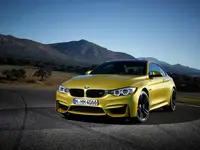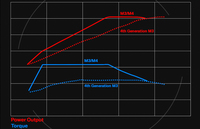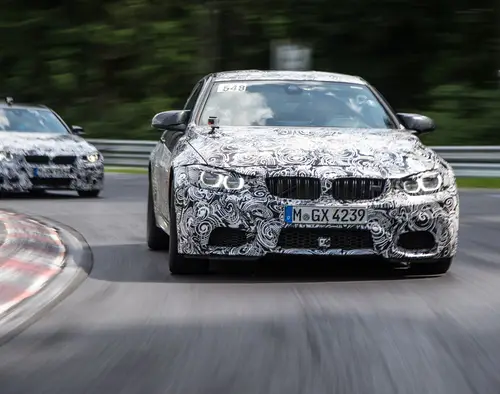SPECIAL INSIDE LOOK: 2014 BMW M4 Technology +VIDEO
By Henny Hemmes
Senior European Editor
The Auto Channel
 2014 BMW M4 |
MUNICH, Germany - January 3, 2014: Last fall I reported on my shotgun ride with a prototype BMW M4. On that occasion, I also talked to the engineers during several M4 workshops. As both the M3 Saloon and M4 Coupe are technically identical, I will refer to them as M4, because this model will be the basis for the upcoming new race car.
The M3 has always played an important role in M GmbH. The first M3 was launched at the IAA in Frankfurt and now, 28 year later, the new generation M3/M4 is a technological center and forges ahead with the tradition of having motor sport genes. In other words: offering lots of power and torque in a light weight construction.
 |
In early 2011, the M Division headed to the Nürburgring. According to Alfred Biermann, responsible for development at M GmbH: “Sometimes with new technology under the old body. But also the M3 GTS did an excellent job as a pilot for technology.” BMW’s race drivers Bruno Sprengler and Timo Glock were involved in development testing at the Ring’s Nordschleife and offered a lot of input for the engineers to proceed with setting up and fine tuning the M4, work that still ongoing.
Timo Glocks talks about and test drives the new BMW M4 and M3
Engine Lots of fans were disappointed by learning that the new BMW M4 is not getting a high revving normally aspirated V8, like the outgoing M3. Instead, the fifth generation M4 gets the in-line six with strong M bi-turbo technology, direct injection, variable valve control (Valvetronic) and variable camshaft timing (Double-Vanos). The power plant was developed completely new for the M twins by more than a hundred engineers and features a newly developed crank case, closed deck design, and cylinder walls that are specially coated for lower friction and better wear.
The goal of the new developments was to generate more power, as well as to retain the M’s high-revving character. The new engine, including the turbochargers and intercooler, is 22 pounds lighter than the V8, partly as a result of optimizing the strength of the cylinder walls and reducing the weight of the pistons.
Watch The Auto Channel's video preview of the 2014 M4 and M3
The 2,979 cc all-aluminum engine has a compression ratio of 10,0:1 and a bore x stroke of 80 x 89.6 mm. The Twinpower Twin turbo technology includes two turbochargers, each on its own three-branch exhaust manifold, and provides 1.3 bar boost.
Although the exact details are not provided yet, the engineers mentioned power output of some 430 hp between 5,500 and 7,300 rpm with a red line of 7,500 rpm. Maximum torque of – according to BMW - “far more” than(369 lb-ft is available from 2,000 to 5,500 rpm. This is well over 30 percent more compared to the outgoing M3.
Oil and Air Flow BMW M has put great effort into lubrication of the high-revving engine, to make sure that there is always oil flow under the high g-loads on a race track. The magnesium sump saves 2.2 lbs compared to an aluminum unit, while a dual oil pump system ensures recirculation of lubricant from left to right, with a suction system to make sure the oil reaches the bearings of the turbochargers.
Important for engine performance is the amount of air that goes into the turbochargers. In this case, air comes through two separate intakes with a filter box for each turbo and goes to the large water cooled, indirect intercooler that sits on top of the engine. “It cannot be closer to the engine,” says Biermann, “therefore the hood needs a large dome.” Dealing with high temperatures is typical for a turbocharged motor, so there is a large radiator and a smaller one for the intercooler and oil cooler.
Although Mr. Biermann did not provide any further details, he could tell us that the M4 is 35 per cent faster than the outgoing M3 from 25 to 93 mph in third gear.
Exhaust system
The exhaust will provide maximum de-throttling. Besides that, M developed an innovative flap concept with electrically controlled exhaust baffles to minimize exhaust back-pressure and to produce a sound that matches the motor sport character of the M4.
Light weight technology
The electromechanical steering gear is specially developed for the M4 and sheds 6.6 pounds of weight. The engine is combined with a six-speed manual gearbox as standard. It is 26 pounds lighter than its predecessor, because it is more compact and also has carbon friction linings in the synchronizer rings. It ‘blips’ the throttle when downshifting; a feature previously unique for the M Double Clutch Transmission.
Optionally available will be the 7-speed M DCT with integrated Launch Control. The power is lead from the transmission via a new propeller shaft. Because is it made of CFRP (carbon fiber reinforced plastic) it has a high rigidity. Therefore, it could be made of one piece, thus shedding the center bearing. The weight saving as some 40 per cent over the two-pie prop shaft in the outgoing M3. The reduction of the rotating mass results in sharper throttle response.
Furthermore, the M engineers developed a CFRP strut brace for the engine compartment, weighing only 3.3 pounds and offering extra rigidity, which also benefits steering response. To get the power to the asphalt, the engineers took the rear axle of the M5 with controlled limited slip differential and mounted the axle beam directly to the body. This results in an even more direct response to steering input.
The front suspension is new and uses a strut brace of carbon composite material. It speaks for itself that like the earlier M3 Coupe generations, the roof of the M4 is made of CFRP. The M3 Sedan also gets this roof for the first time. It saves between 11 and 13.2 lbs in weight. It also lowers the car’s center of gravity. Additionally, the boot lid has been newly developed for optimal aerodynamics - read less lift - and is made of CFRP. The weight distribution is 50:50, while the M4 is around 176 lbs lighter than its predecessor, the M3 Coupe. In other words, the weight of the BMW M4 is less than 3,307 lbs.
Wheels and brakes
The prototype sits on Michelin Pilot Super Sport rubber. Up front the size is 255/35/19 and at the rear 275/35/19. The black wheels partly hide the Brembo carbon brakes, which will be an option on the production models. They feature 6 pistons in the front and 4 in the rear to deal with the higher temperatures generated by the carbon discs. The standard brakes have 4 pistons up front and 4 in the rear. The front discs have a diameter of 15.7 inches.
A true M car..?
 |
Will the 2014 BMW M4 be a true M…? Yes, indeed! Even though I could not drive the superfast coupe myself, the short drive in the passenger seat with BMW race driver Martin Tomczyk was convincing enough (LINK). With a push on the start button, the engine is clearly present and when accelerating it roars impressively.
 |
More important is the throttle response, which is amazingly fast as a result of the constant maximum availability of turbo pressure (100,000 revs), so that the engine reacts like stung by a bee when the pedal is pushed. At lower revs there is 25 per cent more performance, according to Biermann. He also says that the fuel consumption is down, as well as the CO2 emission: “It is going to be under 200 g/km.”
No doubt, I am looking forward to drive the new M4, I’ll have to wait until March. First of all, the new M4 will most likely make its world debut at the Detroit Auto Show on January 13. It is a given fact that the new generation will reach the market this summer.



